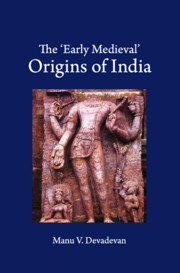Book contents
- Frontmatter
- Dedication
- Contents
- List of Tables
- List of Maps and Figures
- Acknowledgements
- 1 Introduction
- I INSTITUTIONS
- 2 State Formation and Its Structural Foundations
- 3 From the Cult of Chivalry to the Cult of Personality: The Seventh- Century Transformation in Pallava Statecraft
- 4 Changes in Land Relations and the Changing Fortunes of the Cēra State
- 5 Temple and Territory in the Puri Jagannātha Imaginaire
- II IDEAS
- 6 Svayaṃbuddha's Predilections: The Epistemologies of Time and Knowledge
- 7 Bhāravi and the Creation of a Literary Paradigm
- 8 Knowing and Being: The Semantic Universe of the Kūḍiyāṭṭaṃ Theatre
- 9 The Invention of Zero and Its Intellectual Legacy
- III IDENTITIES
- 10 The Evolution of Vernacular Languages: A Case Study of Kannada
- 11 Religious Identities in Times of Indumauḷi's Grief
- 12 Caste, Gender, and the Landed Patriarchy
- 13 The Making of Territorial Self Consciousness (with Particular Reference to Kaliṅga)
- Bibliography
- Index
11 - Religious Identities in Times of Indumauḷi's Grief
Published online by Cambridge University Press: 02 May 2020
- Frontmatter
- Dedication
- Contents
- List of Tables
- List of Maps and Figures
- Acknowledgements
- 1 Introduction
- I INSTITUTIONS
- 2 State Formation and Its Structural Foundations
- 3 From the Cult of Chivalry to the Cult of Personality: The Seventh- Century Transformation in Pallava Statecraft
- 4 Changes in Land Relations and the Changing Fortunes of the Cēra State
- 5 Temple and Territory in the Puri Jagannātha Imaginaire
- II IDEAS
- 6 Svayaṃbuddha's Predilections: The Epistemologies of Time and Knowledge
- 7 Bhāravi and the Creation of a Literary Paradigm
- 8 Knowing and Being: The Semantic Universe of the Kūḍiyāṭṭaṃ Theatre
- 9 The Invention of Zero and Its Intellectual Legacy
- III IDENTITIES
- 10 The Evolution of Vernacular Languages: A Case Study of Kannada
- 11 Religious Identities in Times of Indumauḷi's Grief
- 12 Caste, Gender, and the Landed Patriarchy
- 13 The Making of Territorial Self Consciousness (with Particular Reference to Kaliṅga)
- Bibliography
- Index
Summary
Sometime towards the end of eleventh century, a devotee of Śiva pulled down a Jaina temple (basadi) in Puligeṟe—the present-day Lakṣmēśvara in the Gadaga district of Karnataka—and installed an image of Sōmanātha in its place. He was a merchant and came from Saurāṣṭra. We do not know his name. Kannada sources call him Ādayya, an unlikely name for a Saurāṣṭran merchant. The event seems to have caused great unrest in the region, perhaps even bloodshed, if latter-day accounts are to be believed. It certainly captured the Śaivite imagination, and over the centuries, it has been recounted several times, mostly in ‘Vīraśaiva’ hagiographies.
Over half a century after the destruction of the basadi at Puligeṟe, a similar incident took place at Abbalūru—in the neighbouring Hāvēri district—in which Jainas apparently tried to desecrate the Brahmēśvara temple. Ēkānta Rāmayya, a devotee of Śiva, prevented the desecration by performing a miracle. He severed his own head and put it back again to the consternation of the Jainas assembled there, after taking it on a procession for seven days. The Kaḷacūri king Bijjaḷa II is said to have honoured Rāmayya for performing this spectacle. Like the merchant from Saurāṣṭra, the saviour of Abbalūru has attained a pride of place in hagiographic literature.
Devotees of Śiva, like Ādayya and Ēkānta Rāmayya, were known in the Kannada-speaking region as śaraṇas or protégés of Śiva. Harihara (ca. 1175), one of the greatest ever poets of the Deccan region, was their first hagiographer. He was a junior contemporary of many śaraṇas such as Basava, Allama Prabhu, Cannabasava, Akkamahādēvi, Maḍivāḷa Mācayya, and so on, who are known today for the vacanas they composed. According to Harihara, the śaraṇas were part of Śiva's entourage (gaṇa) in his abode, Kailāsa. Indumauḷi (Śiva) was aggrieved by their sensual lapses and sent them to earth to live a life of carnal fulfilment. They also had a religious mission to accomplish, and the incidents at Puligeṟe and Abbalūru were part of this mission. But latter-day narratives, mostly from the fifteenth and sixteenth centuries, have been zealous in sanitizing the lives of the śaraṇas, as protégés of Śiva were now believed to be too infallible to fall prey to sensual calls.
- Type
- Chapter
- Information
- The ‘Early Medieval' Origins of India , pp. 306 - 340Publisher: Cambridge University PressPrint publication year: 2020



